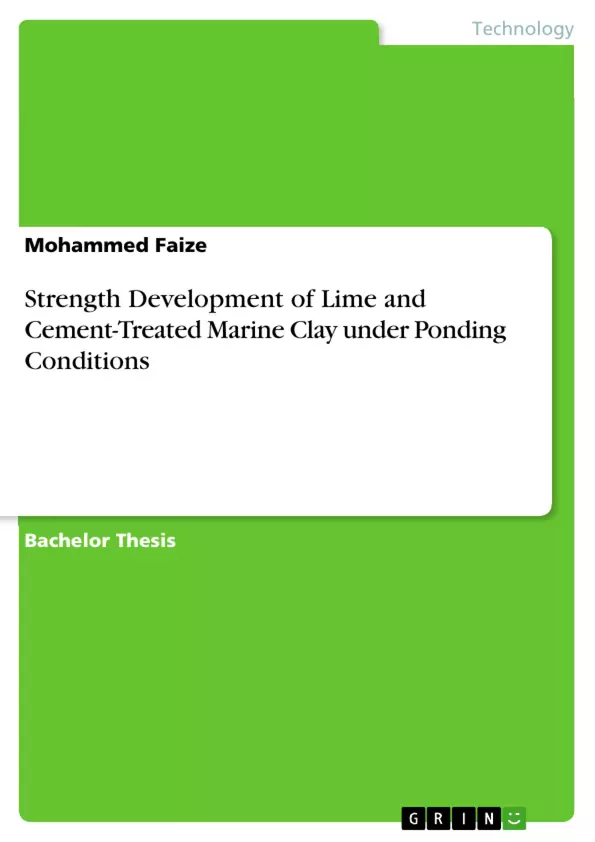In this study, marine clay will be studied by mixing lime and cement in order to determine the strength development especially under ponding condition. The sample is classified based on AASTHO and USCS classification systems by using the Atterberg limits test (liquid limit and plastic limit) and the sieve analysis test, whereas Unconfined Compressive Strength (UCS) and the California Bearing Ratio test (CBR) were conducted to determine the strength before and after adding different percentages of lime and OPC cement.
Treating marine clay is important for further purposed in construction and other infrastructure. Marine clay is considered as soft clay that can not resist heavy load and it found both in the littoral and in a few seaward ranges. The objective of this study is to determine physical and engineering properties of marine clay collected from Kuala Perlis, Malaysia, to investigate the improvement of strength of marine clay treated with lime and cement and investigate the long term effect of lime and cement in treatment marine clay under ponding condition.
Inhaltsverzeichnis (Table of Contents)
- CHAPTER 1: INTRODUCTION
- Research Background
- Introduction
- Research Objectives
- Problem Statement
- Scope of Study
- CHAPTER 2: LITERATURE REVIEW
- Introduction
- Soil
- Classification of Soil
- American Association of State Highway and Transportation (AASTHO)
- Unified Soil Classification System (USCS)
- Clay Mineral and Formation
- Marine Clay
- Soil Improvement
- Lime Stabilization of Soil
- Cement Stabilization of Soil
- The Impact of Climate Change on Soil Processes
- Review of Summary
- CHAPTER 3: METHODOLOGY
- Introduction
- Raw Material Preparation
- Marine Clay
- Cement
- Lime
- Methods of Experiments
- Grain Size Distribution
- Atterberg Limits
- Liquid Limit
- Plastic Limit
- Unconfined Compression Strength (UCS)
- California Bearing Ratio (CBR)
- CHAPTER 4: RESULT AND DISCUSSION
- Introduction
- Characteristics of Marine Clay
Zielsetzung und Themenschwerpunkte (Objectives and Key Themes)
This study aims to investigate the strength development of marine clay treated with lime and cement under ponding conditions. The research focuses on the physical and engineering properties of marine clay, the effectiveness of lime and cement treatment, and the long-term impact of these treatments on the strength of the clay.
- Physical and Engineering Properties of Marine Clay
- Strength Development of Marine Clay Treated with Lime and Cement
- Long-Term Effect of Lime and Cement Treatment under Ponding Conditions
- Influence of Different Percentages of Lime and Cement on Strength
- Comparison of Lime and Cement Treatment Effectiveness
Zusammenfassung der Kapitel (Chapter Summaries)
Chapter 1: Introduction provides an overview of the research background, objectives, problem statement, and scope of the study. It highlights the significance of marine clay treatment for construction and infrastructure development.
Chapter 2: Literature Review delves into the theoretical concepts related to soil, classification systems (AASTHO and USCS), clay minerals, marine clay, and soil improvement techniques, including lime and cement stabilization. It also discusses the impact of climate change on soil processes.
Chapter 3: Methodology outlines the experimental procedures used in the study. This includes the preparation of raw materials (marine clay, cement, and lime), as well as the methods employed for grain size distribution, Atterberg limits, unconfined compressive strength (UCS), and California Bearing Ratio (CBR) tests.
Chapter 4: Result and Discussion presents the findings of the study, analyzing the characteristics of marine clay and the effects of lime and cement treatment on its strength development under ponding conditions.
Schlüsselwörter (Keywords)
Marine clay, lime treatment, cement treatment, strength development, ponding conditions, soil improvement, physical properties, engineering properties, Atterberg limits, unconfined compressive strength (UCS), California Bearing Ratio (CBR), long-term effects, construction, infrastructure.
- Quote paper
- Mohammed Faize (Author), 2017, Strength Development of Lime and Cement-Treated Marine Clay under Ponding Conditions, Munich, GRIN Verlag, https://www.grin.com/document/373115



